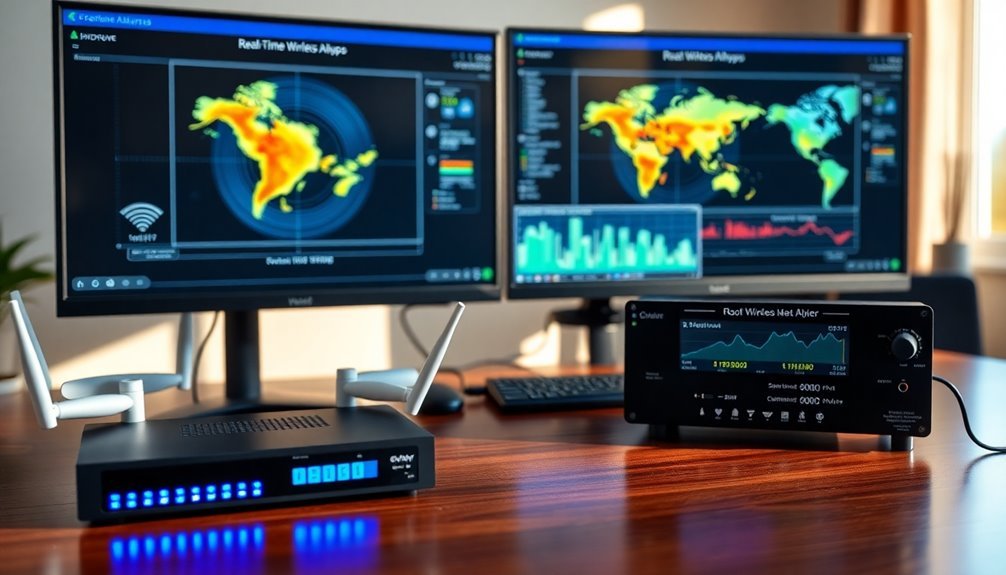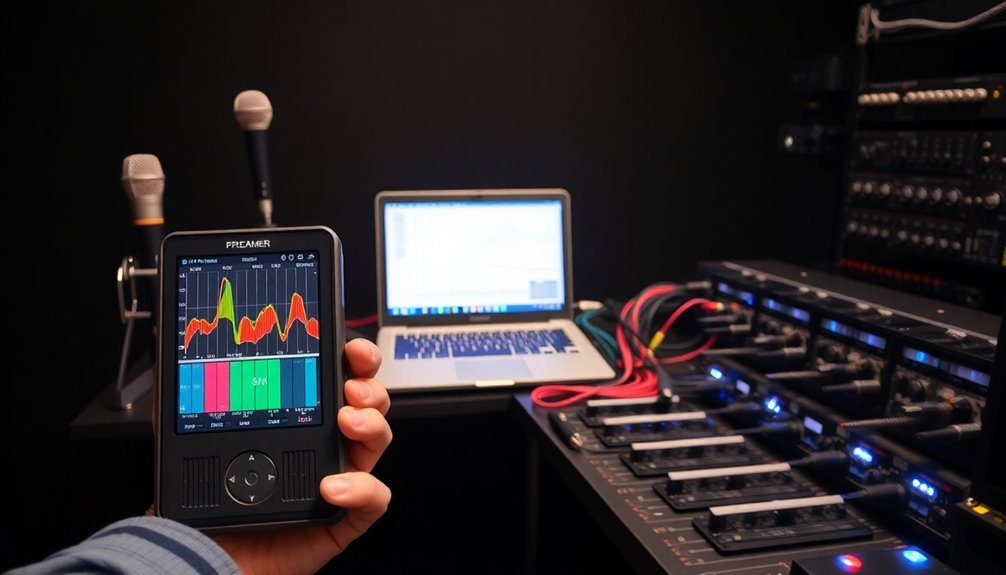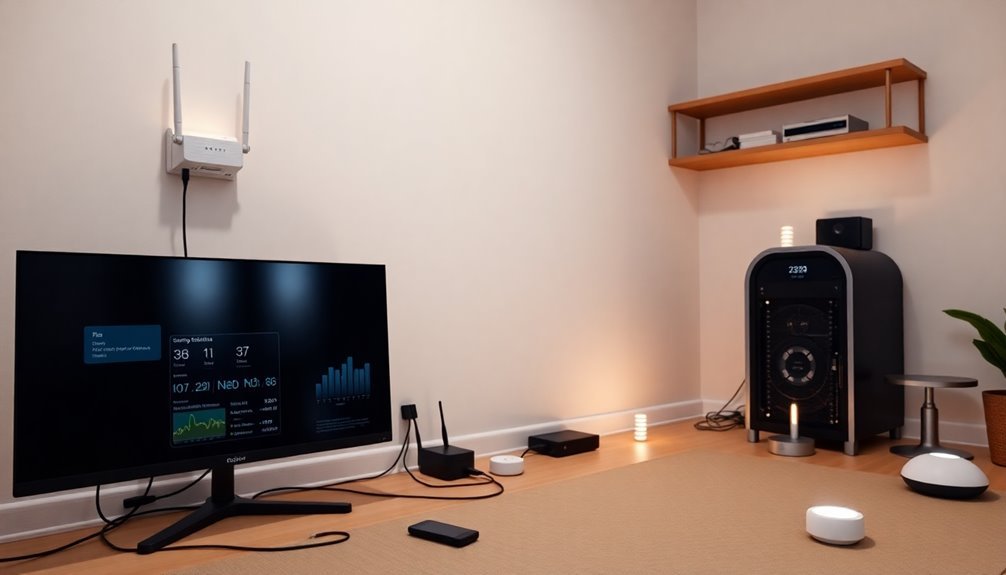Start with thorough network planning by mapping coverage areas and analyzing potential interference sources. You'll want to position sensors strategically in high-traffic zones while eliminating blind spots through careful placement patterns. Optimize signal paths by conducting RF surveys and using spectrum monitoring tools to detect and mitigate interference. Don't forget to implement secure remote access protocols and real-time monitoring capabilities for continuous oversight. Set up automated maintenance schedules, and guarantee proper data management with cloud-based storage solutions. Master these practices and you'll discover the full potential of an enterprise-grade wireless monitoring system.
Network Planning Fundamentals

When setting up wireless monitoring, proper network planning serves as your foundation for reliable performance. You'll need to tackle this process systematically through four essential steps.
Start with coverage planning by analyzing your physical environment. You'll need to assess potential interference sources, determine required signal strengths, and carefully position your access points. An overabundance of APs can lead to unnecessary costs and network contention.
Don't forget to evaluate wall materials and physical obstacles that could impact signal transmission.
Next, focus on capacity planning. You'll want to account for all device types and numbers while preventing intermittent connectivity issues.
Consider your future growth needs and verify your network can scale without performance degradation.
For RF planning, conduct thorough site surveys to identify interference sources. Select appropriate channels, position antennas strategically, and shield sensitive equipment to maintain signal integrity.
You'll need to minimize interference from external networks as well.
Finally, implement your network topology. You can choose between infrastructure mode with Basic Service Sets, extend coverage through multiple BSSs connected by a wired DS, or opt for a mesh topology where APs bridge client traffic.
Each topology choice should align with your specific monitoring requirements.
Strategic Sensor Placement
When setting up your wireless monitoring system, you'll need to position your sensors to achieve ideal signal path coverage while maintaining appropriate distances between network nodes.
You should carefully consider potential physical interference sources, such as metal structures, thick walls, or electronic equipment that could disrupt signal transmission.
To minimize signal degradation, mount your sensors at elevated points and guarantee clear line-of-sight between nodes whenever possible. Aim for a sampling rate of 20Hz for each sensor node to ensure optimal data collection performance.
Maximize Signal Path Coverage
To maximize your wireless monitoring coverage, strategic sensor placement plays an essential role in network security. You'll need to analyze your network topology carefully and identify vital segments where sensors will provide the most thorough monitoring capabilities. Focus on high-traffic areas and potential vulnerability points to guarantee you're capturing essential data flows.
When deploying sensors, you'll want to eliminate blind spots that attackers might exploit. Use attack graph analysis to determine ideal placement positions that cover all potential attack paths while maintaining a cost-effective approach. Low power protocols like ZigBee help optimize energy usage during data transmission.
Consider implementing a combination of inline deployment and VLAN segregation to protect your monitoring communications, especially if you don't have a separate management network available.
You'll achieve better results by using optimization algorithms to determine the most efficient sensor locations. Remember to account for environmental factors that could affect sensor performance and data transmission efficiency.
Balance your deployment between real-time monitoring capabilities and energy consumption concerns. When integrating with existing security infrastructure, verify your sensors work seamlessly with firewalls and other security components. This integrated approach will help you maintain thorough coverage while minimizing the total number of sensors needed.
Distance Between Network Nodes
Strategic sensor placement builds upon network coverage by focusing on the ideal distances between network nodes. You'll need to carefully consider both distance-based strategies and accurate estimation techniques to guarantee peak network performance.
When placing your nodes, use RSSI profiling or Time of Arrival measurements to determine proper spacing between sensors. Random deployment patterns can create coverage holes in your network.
Don't rely solely on uniform placement patterns, as they can lead to inefficient coverage and increased power consumption. Instead, analyze your specific application requirements and adjust node density accordingly. You'll find that higher node densities provide more accurate distance estimations, but they'll also consume more power.
Use configurable coverage protocols like CCP to strike the right balance between coverage and node count.
For accurate distance measurements, you've got several reliable options. While RSSI profiling offers a simple, energy-efficient approach, you might need Time Difference of Arrival or Angle of Arrival methods for more precise positioning.
Remember to factor in your network's traffic flow patterns and potential vulnerability points when determining node placement. If you're implementing an IDS system, position your sensors strategically to monitor critical network segments while maintaining ideal inter-node distances.
Avoiding Physical Interference Sources
Before deploying your wireless sensors, identifying and mapping potential interference sources in your physical environment is essential for peak performance.
You'll need to conduct a thorough site survey to detect any devices or equipment that could disrupt your sensor signals. Use spectrum monitoring tools to analyze the radio frequency environment and identify potential interference patterns.
To effectively locate interference sources, you'll want to employ geolocation techniques that can pinpoint problematic areas with precision.
Start by systematically searching the deployment area using specialized monitoring equipment to detect elusive signals that might impact your sensors' effectiveness. Pay particular attention to areas near electrical equipment, wireless devices, or physical obstacles that could create dead zones or signal degradation.
Once you've identified interference sources, you can implement mitigation strategies such as relocating sensors, adjusting their orientation, or implementing shielding measures.
Consider using formal analysis approaches and network simulators to validate your placement decisions before final deployment. This helps guarantee your wireless monitoring setup maintains ideal coverage while minimizing the impact of physical interference, ultimately strengthening your network's intrusion detection capabilities.
Signal Path Optimization

Effective signal path optimization forms the backbone of reliable wireless monitoring systems.
You'll need to focus on minimizing signal loss while maximizing strength through strategic access point placement and configuration. Consider using 3D ray-tracing models to predict how signals will behave in your specific environment, especially in complex spaces with multiple obstacles. Higher signal attenuation occurs with increased signal reflections, so plan access point placement to minimize bounce paths.
To optimize your signal paths, you'll want to enable airtime fairness and band steering in your WLAN controller settings. This encourages clients to connect to the 5GHz band and helps manage bandwidth allocation efficiently.
Use real-time spectrum analyzers and tools like Wi-Fi Explorer to assess both 2.4GHz and 5GHz networks, identifying potential issues before they impact performance.
Keep in mind that environmental factors greatly affect signal paths. Monitor how weather conditions, building materials, and moving objects influence signal strength.
You'll need to implement dynamic power and channel management to automatically adjust access point settings based on changing RF conditions. When analyzing path loss, factor in free propagation loss, synthesized signal loss, and specific environmental variables.
Select non-overlapping channels to reduce interference and maintain consistent signal quality throughout your wireless network.
Frequency Management Best Practices
You'll need to start with thorough spectrum analysis by scanning your venue multiple times to identify potential interference sources and RF dead zones.
Both indoor and outdoor scans should be performed to evaluate building shielding properties which can significantly impact RF system performance.
Next, you should coordinate your wireless network bands using dedicated software tools like Wireless Workbench to manage frequency assignments and establish proper guard bands between channels.
Once you've mapped out your frequencies, it's essential to maintain ongoing monitoring of your spectrum to quickly detect and address any new sources of interference that could impact your system's performance.
Spectrum Analysis Essential Steps
Successful spectrum analysis begins with mastering essential frequency management practices. You'll need to focus on proper channel selection, regular monitoring, and strategic frequency optimization to maintain a robust wireless network. Start by identifying available channels in the 2.4GHz band, particularly channels 1, 6, and 11, which offer minimal interference overlap. Utilizing spectrum analysis tools throughout implementation and maintenance phases helps ensure optimal network performance.
| Analysis Step | Key Action | Tool Required |
|---|---|---|
| Channel Survey | Check neighboring networks | inSSIDer or equivalent |
| Baseline Setup | Record normal conditions | Spectrum analyzer |
| Interference Check | Monitor signal patterns | Enterprise analyzer |
To effectively manage your wireless spectrum, you'll need to establish baseline measurements and regularly compare new readings against them. Use different trace modes (Normal, Max-Hold, Min-Hold, Average) to capture various signal behaviors. When setting up your monitoring system, consider using narrow RBW for increased sensitivity, but be aware this might miss rapid signal changes. You'll want to implement frequency caps and cross-device tracking to optimize performance across all channels. Remember to adjust your monitoring strategy based on campaign goals – lower frequencies work better for awareness campaigns, while higher frequencies are ideal for retargeting efforts.
Network Band Coordination Tips
Several key strategies form the foundation of network band coordination in wireless monitoring. You'll need to start by scanning your RF spectrum to identify active frequencies that could cause interference.
Then, define your RF spectrum parameters, making sure to consult TV channel databases for thorough coverage planning. Remember to document scan results for future troubleshooting and system optimization.
When coordinating network bands, you'll want to prioritize the 5 GHz and 6 GHz bands over 2.4 GHz whenever possible. These higher frequencies provide more non-overlapping channels and better performance.
Use tools like Wireless Workbench to analyze frequency compatibility and calculate ideal assignments for your devices.
To minimize interference, you should adjust output power levels while maintaining adequate coverage. If you're dealing with signal strength issues, consider adding access points strategically or upgrading to higher gain antennas.
Don't forget to keep coaxial cable lengths minimal to reduce signal loss.
For ongoing enhancement, implement real-time spectrum analysis using tools like ClearWaves. You'll want to monitor intermodulation distortion and lock out problematic frequency ranges, such as DTV stations.
Keep track of signal strength thresholds and regularly adjust channel assignments based on your monitoring results.
Remote Access Configuration

Setting up secure remote access forms the backbone of any wireless monitoring system. You'll need to implement secure protocols like HTTPS or SSH while guaranteeing your firewall settings are properly configured to maintain network security.
For enhanced protection, you should set up a VPN to encrypt all transmitted data and restrict access to authorized personnel only.
To establish reliable connectivity, you'll want to implement a dedicated remote access bridge with LTE capabilities. This provides automatic backup to your Ethernet ports and guarantees continuous network access.
Configure your IP addresses appropriately, whether static or dynamic, and make sure you've got cellular service in place for backup connectivity.
For effective management, set up a centralized control system that lets you monitor multiple network installations. You'll need to configure routing paths between subnets and track essential parameters like battery levels and device status.
This enables quick troubleshooting and faster response times to potential issues.
Remember to choose scalable solutions that can grow with your network needs. Set up email alerts for real-time updates, implement redundant systems, and maintain regular configuration reviews to guarantee peak performance.
Real-Time Monitoring Tools
With your remote access infrastructure in place, you'll need powerful monitoring tools to make the most of your wireless network. Start by implementing automated detection systems that track all wireless access points and connected devices in real-time. You'll want to focus on tools that provide thorough signal strength monitoring and instant alerts for unauthorized access attempts.
| Tool Type | Primary Function | Key Benefit |
|---|---|---|
| Spectrum Analyzer | Channel interference detection | Ideal network performance |
| Heatmap Generator | Coverage visualization | Better AP placement |
| Performance Monitor | Historical data tracking | Proactive troubleshooting |
Choose monitoring solutions that offer detailed access point information, including SSIDs, MAC addresses, and security settings. You'll benefit from tools featuring GPS support for accurate AP mapping and customizable alert thresholds for various network conditions. Make sure your selected platform includes TCP/IP diagnostics and error counters for quick problem resolution. Look for solutions that scale with your network's growth and integrate seamlessly with existing management systems. Consider platforms offering mini window modes for continuous signal strength surveillance while performing other tasks.
System Maintenance Protocols

Maintaining a reliable wireless monitoring system requires an extensive set of protocols that you'll need to follow consistently. Your first priority should be establishing clear roles for system management, including who'll handle notifications and analyze data.
You'll need to register all wireless devices properly and keep contact information current for automated alerts.
Make sure you're regularly checking network connectivity across both Wi-Fi and cellular systems. You'll want to verify signal strength and address any connection issues immediately to prevent monitoring gaps.
Don't forget to implement a backup plan for potential network outages.
Your maintenance schedule should include routine sensor inspections and calibrations. You'll need to clean devices regularly, check battery levels, and replace failing components before they cause system disruptions.
Set up clear thresholds for alerts to avoid unnecessary notifications while ensuring you catch genuine issues.
For data management, you'll want to utilize cloud-based software for analysis and storage. Set up robust security measures to protect system information, and make sure your team's trained to interpret data accurately.
Keep your analysis parameters updated to improve your predictive maintenance capabilities over time.
Frequently Asked Questions
How Frequently Should Wireless Network Security Protocols Be Updated?
You'll need to update your wireless network security protocols monthly for basic maintenance, quarterly for system-wide updates, semi-annually for vulnerability testing, and annually for thorough security policy reviews and assessments.
Can Multiple Wirelesshart Networks Coexist in the Same Physical Space?
Yes, you can have multiple WirelessHART networks coexist successfully. They'll automatically use channel hopping and mesh networking to avoid interference. Just maintain physical separation of >1m between devices for ideal performance.
What Backup Power Solutions Are Recommended for Wireless Monitoring Systems?
You'll need UPS systems with VRLA or lithium-ion batteries, paired with monitoring sensors. Guarantee redundant power supplies and battery backup units for your wireless monitors to maintain continuous operation during outages.
How Do Extreme Weather Conditions Affect Wirelesshart Network Performance?
You'll notice that rain, extreme temperatures, fog, and wind can greatly impact your WirelessHART network. They'll cause signal attenuation, increase packet loss, damage outdoor equipment, and reduce overall network reliability.
Are There Specific Cybersecurity Certifications Required for Wireless Monitoring System Administrators?
You'll need CWNA as your foundation, followed by CWSP for wireless security expertise. While not mandatory, complementary certifications like CISSP or CISM can enhance your credentials as a wireless monitoring administrator.
In Summary
You'll find wireless monitoring success comes down to careful implementation of these seven core practices. By focusing on network planning, strategic placement, signal optimization, frequency management, secure remote access, real-time tools, and consistent maintenance, you're setting yourself up for reliable performance. Don't skip any steps – they work together as an integrated approach to keep your wireless monitoring system running smoothly and efficiently.





Leave a Reply